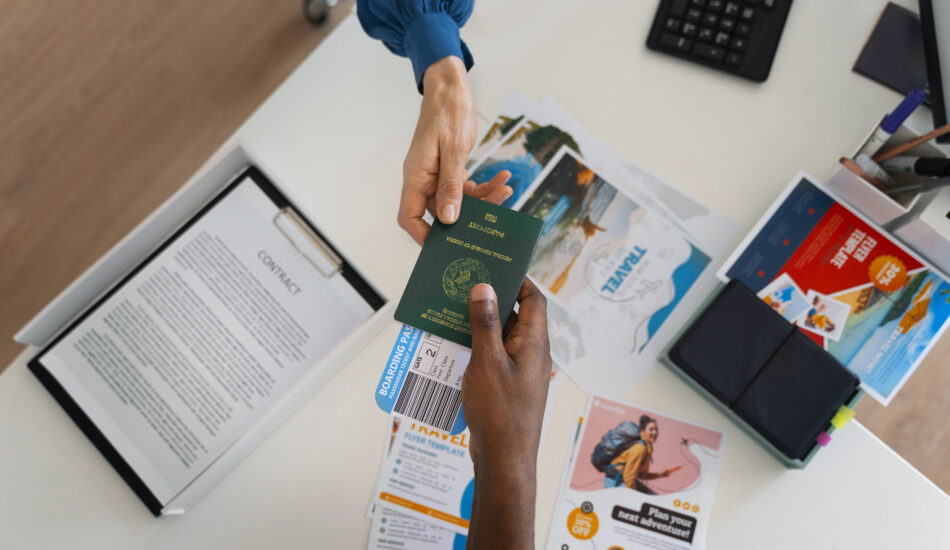Unlock Global Freedom: Your Guide to Form I-131 Travel Documents

What is Form I-131?
U.S. Citizenship and Immigration Services (USCIS) uses Form I-131 for those requiring a travel certificate. Green card holders, refugees, asylees, and other non-citizens wishing to leave the US and re-enter legally temporarily usually utilize the form.
Form I-131 allows you to request three main kinds of travel documents:
- Reentry Permit: Green card holders meant to stay outside the United States for prolonged lengths of time must retain their U.S. resident status with this document.
- Advance Parole: With this permit, those without lawful permanent residency—that is, those with Temporary Protected Status or pending adjustment of status—can travel outside and return to the United States.
- Refugee Travel Documents: This document lets asylees and refugees travel outside the United States and re-enter without losing their status.
Every kind of document serves different roles, hence candidates should select the right one depending on their circumstances.
Eligibility for Form I-131

The people usually submitting Form I-131 are:
- Green Card holders seeking a reentry permit.
- Those with pending immigration applications or Temporary Protected Status (TPS) need advance parole.
- Asylees and refugees need travel documentation.
Applicants must satisfy eligibility criteria based on their present immigration status to file for any of the documents accessible under Form I-131. Ignorance of this may result in rejection of the application.
Fee for Form I-131
The kind of document requested determines the Form I-131 fee:
- Reentry Permit: The application fee is usually $575. Candidates ranging in age from 14 to 79 also have to pay an extra $85 biometric services cost.
- Advance Parole: Usually, using Form I-131 for advance parole costs $575. But if you file together with Form I-485 (Adjustment of Status), the price could be avoided.
- Refugee Travel Document: Applications under the age of 16 pay $135; those over 16 pay $220.
To prevent mistakes, applicants should confirm the exact amount on the official USCIS website. The Form I-131 instructions include a thorough explanation of the fees according to the travel document requested.
How to Apply for Form I-131

Applying for a travel document using Form I-131 calls for both great attention to detail and carefulness. These are the key actions:
-
Obtain the Correct Form
The USCIS website has the application form accessible here. Candidates have to download the most recent version of Form I-131. Before starting the application procedure, be sure you carefully go over the Form I-131 instructions.
-
Choose the Kind of Application You Need
Candidates have to state exactly the kind of travel document they are seeking:
- Reentry Permit: Green card holders who must travel overseas for a prolonged length of time should choose this option.
- Advance Parole: This is your choice if you have to leave the United States and return while your application for adjustment of status is under process.
- Refugee Travel Document: Refugees and asylees should choose this kind of travel documentation for their trips abroad.
Choosing the right document format is essential to prevent application denials or delays.
-
Gather Supporting Documents

Candidates have to provide the appropriate documentation proving their eligibility for the travel document they are seeking. For example, green card holders seeking a reentry permit must show proof of permanent residence; asylees must show documentation of their refugee status.
-
Submit the Filing Fee
Form I-131’s filing fee has to be submitted alongside the application. As mentioned earlier, the kind of document determines the fees. Payments are paid to the U.S. Department of Homeland Security either by check or money order payable. Verify the charge once again before submitting.
-
Attend a Biometrics Appointment
Some applicants, including those seeking a reentry permit, must schedule a biometric services appointment. This involves providing USCIS with photos and fingerprints. Usually, the appointment falls one to two months after the application submission.
-
Send the Application to the Correct Address
Filing addresses for Form I-131 rely on the applicant’s present location and whether it is being filed concurrently with another form, such as Form I-485. The USCIS website offers a thorough instruction on the address for I-131 where applications should be mailed and contain the precise filing address.
-
Track the Processing
Applicants may follow their case status online via the USCIS website upon filing. The kind of travel document affects processing times. Be ready for a wait of several months, although rapid processing may be requested in some situations, such as severe humanitarian requirements.
How Much Time Does Form I-131 Processing Take?

The type of travel document used and the way the USCIS office handles the matter affect processing times for Form I-131 applications. Usually:
- Reentry Permits: Processing takes four to six months.
- Advance Parole: Usually, processing durations run between three to five months.
- Refugee Travel Document: Usually, the schedule runs five to seven months.
USCIS’s web tools allow individuals to monitor processing delays for Form I-131, and applicants living in particular areas may wish to review specific timelines for their region.
What Happens After Biometrics?
Once biometrics are sent in, the travel document starts to be processed. I-131 processing times after biometrics can vary. Candidates should generally expect another few months of processing after biometrics.
While advance parole and refugee travel documentation may be obtained from USCIS offices, the document will be mailed to the U.S. address on file for people seeking a reentry permit.
Special Considerations for Form I-131
Purpose of Trip:
Many times, applicants must show on Form I-131 their reason for the trip. This is specifically important for requesting advance parole or refugee travel documentation for humanitarian or family-related purposes. USCIS requires the accurate offering of this information.
Green Card Holders’ Reentry Permit:
A green card holder who stays outside the United States for prolonged periods without a reentry authorization runs the danger of being seen as abandoning their residency. Form I-131 lets lawful permanent residents get a reentry permit allowing them to spend up to two years outside the United States without losing their green card.
Processing Delays:

Candidates are recommended to apply early in advance of their expected travel dates. Processing delays can arise, particularly if extra documentation is needed or if biometric appointments are delayed. Always verify the I-131 processing time for your particular type of case.
How Long Can You Travel with Form I-131?
The travel document issued will determine the length of time travel is authorized. For example, advance parole normally grants one year, while a reentry permit is usually available for up to two years. Before scheduling travel, be sure to confirm the validity dates mentioned on your document.
Call to Action
Although applying for Form I-131 might be a difficult procedure, candidates can get the required travel paperwork to leave and re-enter the United States without compromising their immigration status with the right information and proof. Whether you’re an asylee needing a travel document or a green card holder seeking a reentry permit, it’s important to know the filing criteria and processing times.
At Passage Law, our area of expertise is helping clients with immigration concerns including Form I-131 preparation and filing. Our knowledgeable immigration lawyers can help you through the application process to guarantee that your travel document is handled as quickly as possible.
Get skilled guidance with your Form I-131 application and arrange a consultation by contacting Passage Law right now. Visit Passage Law to find out more!
